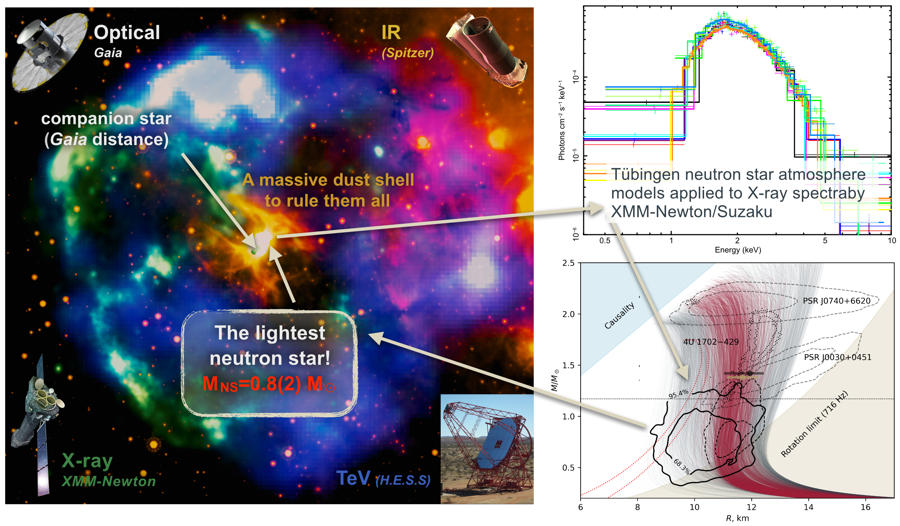The lightest neutron star so far found is located at the center of the supernova remnant HESS J1731-347. Dr. Victor Doroshenko, Dr. Valery Suleimanov, Dr. Gerd Pühlhofer and Professor Andrea Santangelo from the High Energy Astrophysics section of the University of Tübingen's Institute of Astronomy and Astrophysics discovered the unusual object with the help of X-ray telescopes in space. According to calculations by the research team, it has only about half the mass of a typical neutron star. As a basis for their calculations, they used new measurements of the distance to a companion star that the same team had discovered earlier. This allowed the astrophysicists to specify the mass and radius of the neutron star with unprecedented accuracy. Their study has been published in the latest Nature Astronomy.
Neutron stars are born when normal stars with large masses 'die' in a supernova explosion, says lead author Victor Doroshenko. He calls them extreme objects that can be regarded as celestial laboratories for studying basic physics. "Neutron stars have yet unknown properties of matter; they have much higher density than atomic nuclei," the researcher says. Conditions like that could not be replicated in terrestrial laboratories. "Space-based observations of neutron stars with extreme properties such as the one we've just found, using X-ray or other telescopes will allow us to solve the mysteries of super-dense matter - at least if we can solve challenges such as the inaccuracy of measurements over such distances that arises during observations. We have now succeeded in doing just that - pushing the knowledge about these mysterious objects a bit further."
Precise calculations
The neutron star at the center of the supernova remnant HESS J1731-347 was one of a handful of objects discovered during gamma-ray measurements with the H.E.S.S. telescopes in Namibia and subsequently studied by X-ray telescopes from space, Doroshenko reports. "Only then did the cooling neutron star become visible," adds Gerd Pühlhofer. The peculiarity of this object, as the same research team had noted earlier, is that it is physically connected to another star. That star illuminates the dust cloud around the neutron star, heats it and makes it shine in the infrared light. The companion star was recently observed by the European Space Agency's Gaia space telescope, which provided the research team with accurate distance measurements to both objects. The Gaia mission involves a high-precision three-dimensional optical survey of the sky. "This allowed us to resolve previous inaccuracies and improve our models," Pühlhofer said. The mass and radius of the neutron star could be determined much more precisely than was previously possible," explains theoretical astrophysicist Valery Suleimanov.
It is not yet clear how the unusual object formed, he says. There are also doubts as to whether it is actually a neutron star or whether the object is a candidate for an even more exotic object made of strange quark matter, says Andrea Santangelo, adding, "This is currently the most promising quark or strange-matter star candidate we know of so far, even if its properties are consistent with those of a 'normal' neutron star." But even if the object at the center of HESS J1731-347 is a neutron star, it remains an interesting and puzzling object. "It allows us to probe the yet unexplored part of the parameter space in the mass-radius plane of neutron stars. This will enable us to put valuable constraints on the equation of state of dense matter, which is used to describe its properties" Santangelo says.
Publication:
Victor Doroshenko, Valery Suleimanov, Gerd Pühlhofer and Andrea Santangelo: A strangely light neutron star within a supernova remnant. Nature Astronomy, 24. Oktober 2022, https://doi.org/10.1038/s41550-022-01800-1







